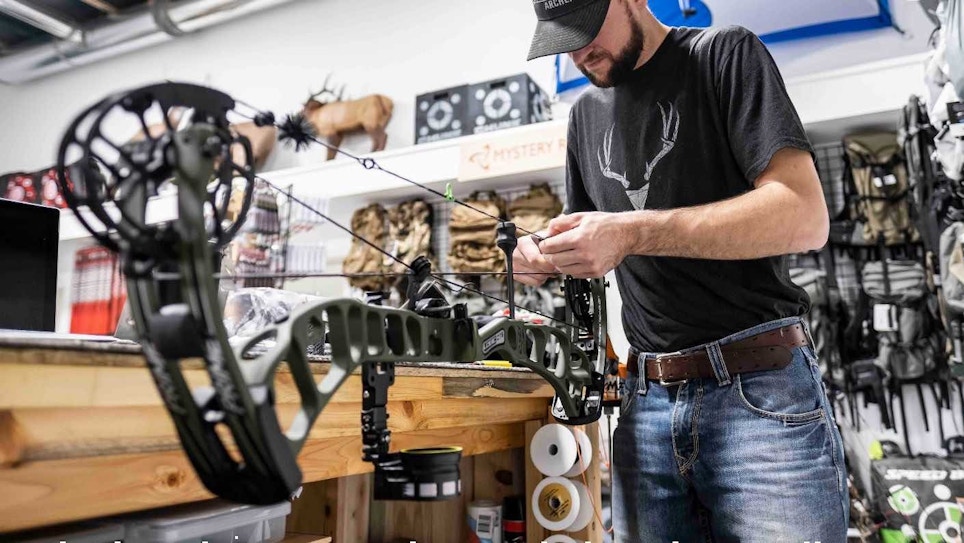Mark Wagner
Altoona, Iowa
Both Elite’s and Bowtech’s cam systems are revolutionary. They’re adjustable without a bow press. It has helped bow technicians and pro shops tune bows more efficiently. I’m a huge fan.
For equipment, draw boards provide a major advantage for checking cam synchronization. Also, the new bow vises that allow you to set the sight’s second and third axis have really helped me. There are also other tools out there for the axis adjustments, and those are great, too.
Before a bow leaves our store, we set the centershot and level everything up. Then, the customer shoots arrows through paper. That allows us to adjust the bow to the customer during paper tuning. We get it right before they take the bow home, but we also ask them to bring the bow back in after a couple hundred shots so that we can check everything and tune it again, if needed.
The quality bowstrings and cables out there are highly beneficial for bow technicians. The settle-in period is minimal and even nonexistent in many cases. Most times when customers return after a couple hundred shots, the bow is still tuned and ready to go. The customer is happy, and it saves us time.
I do have some lasers and use them occasionally, but more often I go through all of the measurements and make adjustments until the bow meets all manufacturer specs.
And then the last thing is a good D-loop plier. It gives me the ability to stretch tight loops, and it’s so much easier than the old way of pulling with a release or hex wrench.
Bryan Schertz
Canton, Texas
We use a good, solid bow vise made by HTM. It helps us tremendously when we set the second- and third-axis adjustments on bowsights. We use that vise religiously. We also use a string square. A few different options that are available all use the same concept, but we use the HTM model. Those two tools are the most critical ones we use during set up.
We also use a 6-inch steel measuring device. With it, we check the centerline of the arrow in conjunction with the riser. We use it to check cam rotation so we can synchronize cams. And, we use it a lot on crossbows.
A lot of archery shops don’t use micrometers. We do. We’ll check bowstring center serving sizes to make sure they match the arrow nock. We use it on the inside and outside of D-loops. Especially with tournament bows, folks are very sensitive to draw length, so the micrometer helps us to install the right loop length so that we don’t alter the bow’s draw length.
We also log all of the customer’s bow information. We sort of call it a “birth certificate.” We keep it on file. We know exactly what length the D-loop was when the bow went out the door. That way, if a customer returns and says that something feels amiss, we can pull out the micrometer and check things over against our records to see what has changed.
Another thing is a draw board. I made the one I use myself 18 years ago before they were sold commercially. With it, I can check the cam timing and actual draw length.
We’re doing a lot more bare-shaft tuning these days. We’ve been doing it a while, but it’s more popular now. We’ll do it with tournament and bowhunting bows. Guys who are going on once-in-a-lifetime hunts really see the benefit. We want to make sure that their broadheads fly just like their field tips, and the bare-shaft tuning always helps. We do that free of charge if the customer purchases the bow through us.
Jessie Smith
Charlotte, North Carolina
I really like the LCA EZ Press. Just about everybody uses that. I use lasers for tuning bows, and I use a level kit. Those tools have changed the way I work on and tune bows. And the newest one that I’ve added is a Baker Archery Products bow vise. It helps me seamlessly level the bows and get everything squared. It has a ball system so that I can orient the bow any way I want, plus it allows third-axis leveling.
We’ve grown so accustomed to it that we rarely think about how revolutionary the D-loop is. Years ago, we just had a string nock and hooked our releases to our bowstrings. It eliminates the pinching factor and produces a cleaner release, making the bow easier to tune.
With the lasers and the technology, I don’t have to get into bare-shaft tuning or even paper tuning unless I’m trying to pinpoint a problem. The tools we have at our disposal reduce a lot of the manual labor of setting up and tuning a bow. Paper tuning and bare-shaft tuning are nice, and I certainly fall back on them when necessary, but I don’t always have the need to do them.
Never has it been simpler, despite all of the advanced technology, to effectively tune a modern compound bow. I’m just amazed at how quickly I can set up a bow with all of my tools and equipment.






